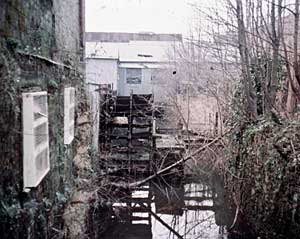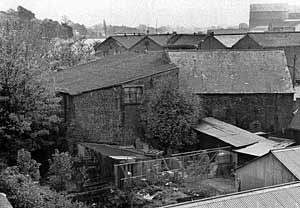
Lower Mill
Page updated 25 August 2009
Situated between Cricklepit and the Custom House, this mill was constructed on this site in 1554, by a syndicate of merchants and lawyers, who leased the land from the City Chamber for six years at a rent of 6s 8d. The mill had four stocks, which were probably arranged in pairs, alternatively beating the woollen cloth – the clacking noise of these stocks, along with the stocks of all the other fulling mills, would have reverberated all over Exe Island, Shilhay and up the streets of the West Quarter. Henry and Margery Harris seemed to have built the mill, and were responsible for sub-letting to various fullers.
In 1606, there was a dispute between Hugh Armstrong, fuller of the Lower Mill, and the occupants of Cricklepit Mill, over the opening and shutting of hatches, fenders and sluices, which was affecting the water flow to his wheel – it was common to have disputes over the flow of water, and in the 19th Century, some ended in lengthy court cases. In 1609, the City Chamber leased the mill to James Taylor after the reversion of Margery Harris's lease which was due to expire in 1619. Taylor leased the mill for 99 years on the lives of his two children, and the child of John Marshall, merchant. James Taylor died in 1622 leaving leases and chattels valued at £280. His son, Henry Taylor continued fulling before he died in 1638, and by 1652, half the mill was let to John Rowe, a Crediton clothier. By 1679, John Boyland was leasing Lower Mills for a term of nineteen years.
The above clearly shows the ownership pattern of a mill, with the City owning the land and leat, a merchant constructing and leasing the mill and the fullers sub-letting from the merchant. It was not until after 1660 that tuckers could become direct tenants of the City, but this was not widespread, as mill owners would employ their own fullers, or sublet to fullers who would full the serge for cloth finishers or merchants at piece rates (he would be paid a fixed rate per item).
The 19th Century
The first mention of Lower Mill in the Exeter Flying Post, was in December 1819, when a for sale notice stated that the brick built three storey mill, including the mill house, had both a single and double wheel, and five stocks engaged in fulling. It also had a cloth drying loft over the mill. The former occupants had been Messrs, Gilbard and Mugford, fullers. Sometime after, the mill was converted to milling corn, as the woollen industry had collapsed, and by 1844, the mill was listed in Pigots with William Bowden as the corn miller.
From before 1866, when a six-horse portable steam engine was offered for sale, to 1879, the mills were worked by Woodbridge and Sons. William Woodbridge, a miller and corn factor, was born in 1813 and lived in Haven Banks House. He not only ran the Lower Mill, but he also worked Cricklepit Mill. William Woodbridge died in April 1879 at the age of 67 and was buried in the Lower Cemetery, beneath the catacombs. In 1881, his son, also William, was living in Alphington and had taken over the business, employing 7 men and 2 boys.
Lower Mill was flooded in October 1875 and some sacks of flour were left standing in two feet of water. Two years later and Mr John Woodbridge won the tender for supplying flour at £2 4s 11d a sack to the St Thomas Board of Guardians.
When the mill was offered for sale in 1881 it had the following fixtures and machinery - "....smut, flour and winnowing machines, troughs, elevators, silks, corn crushing mill, oil cake crusher, disintegrator, chaff-cutter, steam engine, boiler, and fittings, &c." (FP) and was occupied by William Burrows. The mill was up for sale again in June 1895, when it was described as a flour mill, still occupied by Mr W Burrow. In 1898 the mill was engaged in both producing flour and also used as a saw mill, when the lease was put up for sale by Frederick Hooper Turner and Legh Charles Calley. The mill was leased to William George Shears at a rate of £62 10s. The premises included three stables and a loose box.
The mill was destroyed by a fire in the early 20th Century and the site put up for sale in 1923. It became Shears Lower Mill, driving a pair of flat millstones, for grist milling. This mill burnt down, as a possible victim of arson, in April 1934, but was rebuilt by W Brown and Co, using the old water wheel to drive a high speed vertical millstone. The mill was still working in 1970 using electrically driven machinery for grinding animal feedstuffs. A single, working 18ft undershot wheel is still in position, although in poor condition.
Sources are listed on the mills menu page.
 The neglected Lower Mill wheel was driven
by the Higher Leat – Cricklepit Mill is in the background. Photo
Alan H Mazonowicz
The neglected Lower Mill wheel was driven
by the Higher Leat – Cricklepit Mill is in the background. Photo
Alan H Mazonowicz  The Lower Mill sometime in the 1970s – the
wheel can just be seen, bottom left. Photo Alan H Mazonowicz
The Lower Mill sometime in the 1970s – the
wheel can just be seen, bottom left. Photo Alan H Mazonowicz
│ Top of Page │